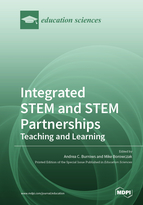Integrated STEM and STEM Partnerships: Teaching and Learning
A special issue of Education Sciences (ISSN 2227-7102). This special issue belongs to the section "STEM Education".
Deadline for manuscript submissions: closed (31 July 2022) | Viewed by 31021
Special Issue Editors
Interests: science education; STEM integration; teaching and learning partnerships; teaching; pedagogy and education; professional development; teacher training; curriculum development; pedagogy; collaborative learning; teaching experience
Special Issues, Collections and Topics in MDPI journals
Interests: secure distributed systems; security and resilience of autonomous systems; continuous and adaptive authentication; cyber-physical systems and applications; hardware-level security for lightweight agents
Special Issue Information
Dear Colleagues,
The overall focus of this Special Issue is on educational spaces relating to integrated STEM and interdisciplinary partnerships that might occur in integrated STEM spaces. These educational spaces include formal and informal schooling and could include studies involving collaborative work teams, pre-service or in-service teachers, STEM faculty experiences, pre-collegiate students, interdisciplinary education, science education, technology education, engineering and computer science education, or mathematics education. The purpose of this Special Issue is to bring together a showcase of current studies in integrated STEM and related partnership work in teaching and learning. The newly released Handbook of Research on STEM Education (Johnson, Mohr-Schroeder, Moore, and English, 2020) explores areas of STEM in an international context and sets the stage for this Special Issue. Attention to utilizing integrated STEM frameworks is encouraged. Future research on effective integrated STEM practices and supports is presented in the Handbook of Research on STEM Education and serves as a springboard for Special Issue submissions. Additionally, we welcome studies involving interdisciplinary teams or individuals (that integrate information, data, techniques, tools, perspectives, concepts, and/or theories from two or more disciplines (nsf.gov)) as well as transdisciplinary work (showing a practical focus and skills) that might not traditionally be found in integrated STEM literature.
Dr. Andrea C. Burrows
Dr. Mike Borowczak
Guest Editors
Manuscript Submission Information
Manuscripts should be submitted online at www.mdpi.com by registering and logging in to this website. Once you are registered, click here to go to the submission form. Manuscripts can be submitted until the deadline. All submissions that pass pre-check are peer-reviewed. Accepted papers will be published continuously in the journal (as soon as accepted) and will be listed together on the special issue website. Research articles, review articles as well as short communications are invited. For planned papers, a title and short abstract (about 100 words) can be sent to the Editorial Office for announcement on this website.
Submitted manuscripts should not have been published previously, nor be under consideration for publication elsewhere (except conference proceedings papers). All manuscripts are thoroughly refereed through a double-blind peer-review process. A guide for authors and other relevant information for submission of manuscripts is available on the Instructions for Authors page. Education Sciences is an international peer-reviewed open access monthly journal published by MDPI.
Please visit the Instructions for Authors page before submitting a manuscript. The Article Processing Charge (APC) for publication in this open access journal is 1800 CHF (Swiss Francs). Submitted papers should be well formatted and use good English. Authors may use MDPI's English editing service prior to publication or during author revisions.
Keywords
- Integrated STEM
- Pre-service and in-service teacher education
- Faculty experiences
- Pre-collegiate education
- Partnerships
- Interdisciplinary teams
- Science education
- Technology education
- Engineering and computer science education
- Mathematics education







